-
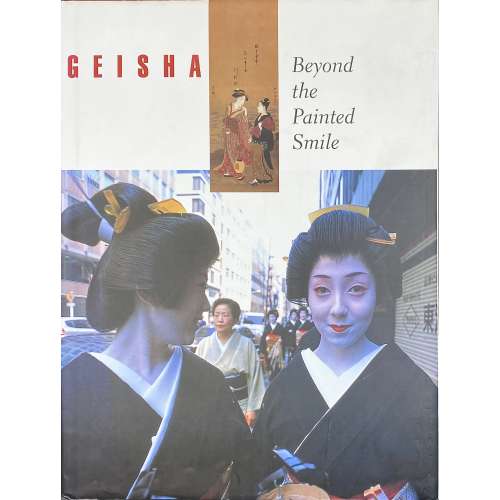 Description: one volume, 31.3 x 23.8 cm, bound in crimson cloth with gilt lettering to spine, in a pictorial dust jacket, lettered to front: GEISHA | {image} | Beyond | the | Painted | Smile | {image} || Title-page: GEISHA | Beyond | the | Painted | Smile | edited by the | Peabody Essex | Museum | published by | George Braziller, Inc. | in association with the | Peabody Essex Museum || Pagination: 1-159 [160], ils. Contributors: Lisa Dalby, Lesley Downer, Arthur Golden, Peter M. Grilli, Money L. Hickman, Allen Hockley, Andrew L. Maske, Yoko Yamamoto.
Description: one volume, 31.3 x 23.8 cm, bound in crimson cloth with gilt lettering to spine, in a pictorial dust jacket, lettered to front: GEISHA | {image} | Beyond | the | Painted | Smile | {image} || Title-page: GEISHA | Beyond | the | Painted | Smile | edited by the | Peabody Essex | Museum | published by | George Braziller, Inc. | in association with the | Peabody Essex Museum || Pagination: 1-159 [160], ils. Contributors: Lisa Dalby, Lesley Downer, Arthur Golden, Peter M. Grilli, Money L. Hickman, Allen Hockley, Andrew L. Maske, Yoko Yamamoto. -
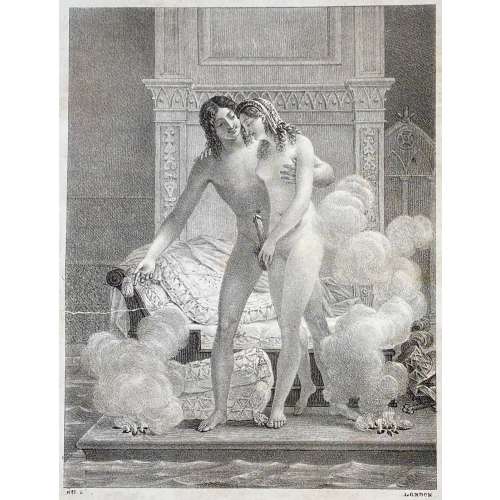 Description: Two volumes in one, collated 4to, 32.5 x 25.3 cm, bound in 19th-century long-grain green shagreen, flapped portfolio with a bronze lock clasp, gilt centrepiece fleuron, gilt- and blind-tooled boards and spine, spine with false raised bands, gilt-lettered "ESSAI | SUR LA MORALE"; text printed on bluish laid paper, blue marbled pastedowns; h.t. and t.p. in both volumes present. Restoration and conservation by Zukor art conservation in September 2022. Title-page: LA PUCELLE | D'ORLÉANS, | POËME EN VINGT-UN CHANTS. | Par VOLTAIRE | Édition ornée de Figures gravées par les meilleurs | Artistes de Paris. | — | TOME PREMIER (TOME SECOND). | — | A PARIS, | DE L’IMPRIMERIE DE DIDOT LE JEUNE. | L’AN TROISIÈME. || Imprint: A PARIS, | Chez les Frères Jacquenod, rue de Condé, no. 15. | A LYON, chez les mêmes. || Collation: Vol. 1: A-Z4, 2A-2H4 2I2; total 126 leaves; Vol. 2: A-Z4, 2A4 2B2, 2C-D4, 2E3 2F-2N4; total 141 leaves; first and last blank, plus 21 plates extraneous to collation, 8 in the 1st volume (incl. frontispiece) and 13 in the 2nd. Pagination: Vol. 1: [1-5] 6-251 [252], total 252 pages, ils; Note: leave 2A1 has a loss of 1/6 of the top, leave 2A2 torn out completely; Vol. 2: [1-5] 6-212, 2[211] 2212 [213] 214-279 [280], duplication of numbers 211 and 212 => total 282 pages, ils. The total number of pages in the volume is 534; one page torn out (187/8 in Vol. 1) Catalogue raisonné: Nordmann (2): № 562, p. 278; Cohen-deRicci: 1034. According to Nordmann (Christie’s), it was an edition illustrated with 21 plates after Lebarbier, Marillier, Monnet and Monsiau produced by various engravers; in the 1840s those plates were replaced with 24 lithographs by Achille Devéria, who signed them “LONDON”. In Nordmann’s copy, there is also a set of hand-coloured lithographs. There are only 21 plates in our copy, lacking three as per the source. Contributors : François Marie Arouet de Voltaire (French, 1694 – 1778) – author. Achille Devéria (French, 1800 – 1857) – artist. Pierre-Nicolas-Firmin Didot [Didot le Jeune] (French, 1769 – 1836) – publisher.
Description: Two volumes in one, collated 4to, 32.5 x 25.3 cm, bound in 19th-century long-grain green shagreen, flapped portfolio with a bronze lock clasp, gilt centrepiece fleuron, gilt- and blind-tooled boards and spine, spine with false raised bands, gilt-lettered "ESSAI | SUR LA MORALE"; text printed on bluish laid paper, blue marbled pastedowns; h.t. and t.p. in both volumes present. Restoration and conservation by Zukor art conservation in September 2022. Title-page: LA PUCELLE | D'ORLÉANS, | POËME EN VINGT-UN CHANTS. | Par VOLTAIRE | Édition ornée de Figures gravées par les meilleurs | Artistes de Paris. | — | TOME PREMIER (TOME SECOND). | — | A PARIS, | DE L’IMPRIMERIE DE DIDOT LE JEUNE. | L’AN TROISIÈME. || Imprint: A PARIS, | Chez les Frères Jacquenod, rue de Condé, no. 15. | A LYON, chez les mêmes. || Collation: Vol. 1: A-Z4, 2A-2H4 2I2; total 126 leaves; Vol. 2: A-Z4, 2A4 2B2, 2C-D4, 2E3 2F-2N4; total 141 leaves; first and last blank, plus 21 plates extraneous to collation, 8 in the 1st volume (incl. frontispiece) and 13 in the 2nd. Pagination: Vol. 1: [1-5] 6-251 [252], total 252 pages, ils; Note: leave 2A1 has a loss of 1/6 of the top, leave 2A2 torn out completely; Vol. 2: [1-5] 6-212, 2[211] 2212 [213] 214-279 [280], duplication of numbers 211 and 212 => total 282 pages, ils. The total number of pages in the volume is 534; one page torn out (187/8 in Vol. 1) Catalogue raisonné: Nordmann (2): № 562, p. 278; Cohen-deRicci: 1034. According to Nordmann (Christie’s), it was an edition illustrated with 21 plates after Lebarbier, Marillier, Monnet and Monsiau produced by various engravers; in the 1840s those plates were replaced with 24 lithographs by Achille Devéria, who signed them “LONDON”. In Nordmann’s copy, there is also a set of hand-coloured lithographs. There are only 21 plates in our copy, lacking three as per the source. Contributors : François Marie Arouet de Voltaire (French, 1694 – 1778) – author. Achille Devéria (French, 1800 – 1857) – artist. Pierre-Nicolas-Firmin Didot [Didot le Jeune] (French, 1769 – 1836) – publisher. -
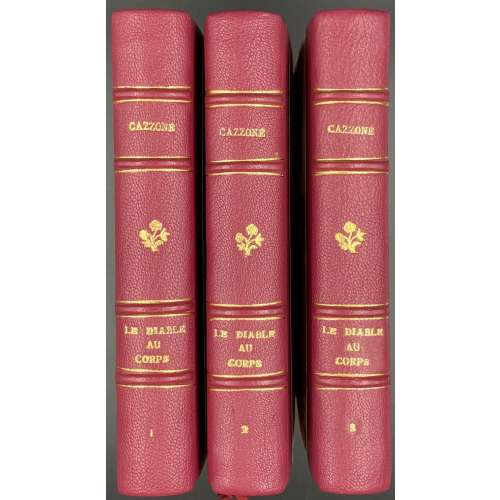 Description: Three volumes, 17 x 14 cm each, uniformly bound in quarter crimson morocco over marbled boards, spine with raised bands tooled gilt with gilt lettering and fleuron, marbled endpapers, publisher’s wrappers preserved (moire-waffle in light pink (vol. 1), cream (vol. 2) and blue (vol. 3), engraved), printed on wove paper, outer and bottom margin untrimmed, illustrated with etched/aquatint front wrapper, frontispiece, tail- and headpieces, and full-page plates in sepia, presumably after Zyg Brunner. Title-page (red and black): LE DIABLE | AU | CORPS | ŒUVRE POSTHUME | DU TRÈS RECOMMANDABLE DOCTEUR | CAZZONÉ | (ANDRÉA DE NERCIAT) | Membre extraordinaire de la joyeuse Faculté | phallo-coîro-pygo-glottonomique | TOME PREMIER (DEUXIÈME; TROISIÈME) | ALENÇON | 1930 || Vol. 1: front wrapper, blank leaf, h.t./limitation, t.p., [1] 2-180, 2 blank leaves, back wrapper; frontispiece, 7 full-page plates (incl. frontispiece), and 13 tail- and headpieces. Vol. 2: front wrapper, blank leaf, h.t./limitation, t.p., [1] 2-193 [194 blank], blank leaf, back wrapper; 8 full-page plates (incl. frontispiece), and 12 tail- and headpieces. Vol. 3: front wrapper, blank leaf, h.t./limitation, t.p., [1] 2-180 [181 colophon], [182 blank], blank leaf, back wrapper; frontispiece, 8 full-page plates (incl. frontispiece), and 13 tail- and headpieces. Limitation: 30 copies (№ 1-30) on Japon Impérial, 300 copies (№ 31-331) on Vélin d’Arches. This copy is № 109. Colophon: Printed on May 25, 1930, 350 copies on Vélin d’Arches with numbers from 31 to 380 [sic!] Catalogue raisonné: Dutel (1920-1970) № 1394, p. 129. Contributors: André-Robert Andréa de Nerciat (French, 1739 – 1800) – author. Zyg [Zygismund; Sigismond Leopold] Brunner (Polish, 1878 – 1961) – artist.
Description: Three volumes, 17 x 14 cm each, uniformly bound in quarter crimson morocco over marbled boards, spine with raised bands tooled gilt with gilt lettering and fleuron, marbled endpapers, publisher’s wrappers preserved (moire-waffle in light pink (vol. 1), cream (vol. 2) and blue (vol. 3), engraved), printed on wove paper, outer and bottom margin untrimmed, illustrated with etched/aquatint front wrapper, frontispiece, tail- and headpieces, and full-page plates in sepia, presumably after Zyg Brunner. Title-page (red and black): LE DIABLE | AU | CORPS | ŒUVRE POSTHUME | DU TRÈS RECOMMANDABLE DOCTEUR | CAZZONÉ | (ANDRÉA DE NERCIAT) | Membre extraordinaire de la joyeuse Faculté | phallo-coîro-pygo-glottonomique | TOME PREMIER (DEUXIÈME; TROISIÈME) | ALENÇON | 1930 || Vol. 1: front wrapper, blank leaf, h.t./limitation, t.p., [1] 2-180, 2 blank leaves, back wrapper; frontispiece, 7 full-page plates (incl. frontispiece), and 13 tail- and headpieces. Vol. 2: front wrapper, blank leaf, h.t./limitation, t.p., [1] 2-193 [194 blank], blank leaf, back wrapper; 8 full-page plates (incl. frontispiece), and 12 tail- and headpieces. Vol. 3: front wrapper, blank leaf, h.t./limitation, t.p., [1] 2-180 [181 colophon], [182 blank], blank leaf, back wrapper; frontispiece, 8 full-page plates (incl. frontispiece), and 13 tail- and headpieces. Limitation: 30 copies (№ 1-30) on Japon Impérial, 300 copies (№ 31-331) on Vélin d’Arches. This copy is № 109. Colophon: Printed on May 25, 1930, 350 copies on Vélin d’Arches with numbers from 31 to 380 [sic!] Catalogue raisonné: Dutel (1920-1970) № 1394, p. 129. Contributors: André-Robert Andréa de Nerciat (French, 1739 – 1800) – author. Zyg [Zygismund; Sigismond Leopold] Brunner (Polish, 1878 – 1961) – artist. -
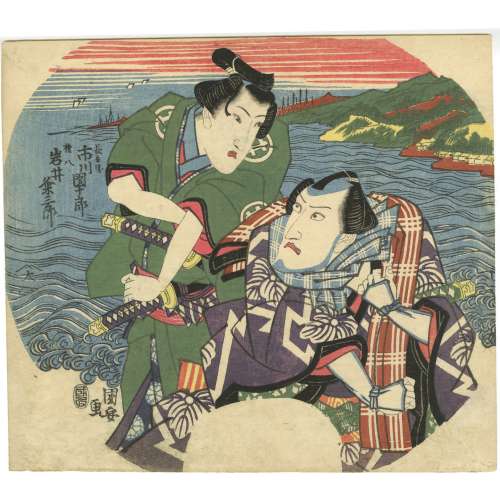 Artist: Utagawa Kuniyasu [歌川 国安] (Japanese, 1794–1832). Publisher seal: [太] (Ta): Marks 02-050 | U421b: An unknown publisher in Edo, fl. c. 1815-61; name assigned according to seal shape “Yama-Ta“. Signed: Kuniyasu ga [国安 画]. Date-aratame seal: Bunsei 9 (1826). Actors: Iwai Hanshirō VI [岩井半四郎] (Japanese, 1799 – 1836), other names: Iwai Hanshirō VI, Iwai Kumesaburō II, Iwai Hisajirō I, Baiga (poetry name), Shūka (poetry name) — as Shirai Gonpachi [白井權八]. Ichikawa Danjūrō VII 市川団十郎 (Japanese, 1791 – 1859), other names: Ichikawa Ebizō V, Ichikawa Hakuen II, Ichikawa Shinnosuke I — as Banzui Chōbei [幡随長兵衛]. Kabuki play: Suzugamori [Suzu-ga-Mori, 鈴ヶ森], a.k.a. Ukiyozuka Hiyoku no Inazuma written by Tsuruya Nanboku IV (Japanese, c. 1755 – 1829). First staged in 1823 at Ichimura-za [市村座] in Edo. Plot: "A gang of evil palanquin bearers are stationed near the Suzugamori execution grounds, where they lay in wait to rob travellers passing through. Gonpachi, who killed a man in his home province, is being sought by the police. He is fleeing to Edo when the bearers attack him in hopes of claiming a reward. He beats them off with great skill. Banzui Chōbei, who is being carried by in a palanquin, sees the attack, admires Gonpachi's ability, and promises to aid him if he is going to Edo". [Samuel L. Leiter. Historical Dictionary of Japanese Traditional Theatre. — Rowman & Littlefield, 2014; p. 382-3.; LIB-2110.2019]. Ref.: Sotheby's.
Artist: Utagawa Kuniyasu [歌川 国安] (Japanese, 1794–1832). Publisher seal: [太] (Ta): Marks 02-050 | U421b: An unknown publisher in Edo, fl. c. 1815-61; name assigned according to seal shape “Yama-Ta“. Signed: Kuniyasu ga [国安 画]. Date-aratame seal: Bunsei 9 (1826). Actors: Iwai Hanshirō VI [岩井半四郎] (Japanese, 1799 – 1836), other names: Iwai Hanshirō VI, Iwai Kumesaburō II, Iwai Hisajirō I, Baiga (poetry name), Shūka (poetry name) — as Shirai Gonpachi [白井權八]. Ichikawa Danjūrō VII 市川団十郎 (Japanese, 1791 – 1859), other names: Ichikawa Ebizō V, Ichikawa Hakuen II, Ichikawa Shinnosuke I — as Banzui Chōbei [幡随長兵衛]. Kabuki play: Suzugamori [Suzu-ga-Mori, 鈴ヶ森], a.k.a. Ukiyozuka Hiyoku no Inazuma written by Tsuruya Nanboku IV (Japanese, c. 1755 – 1829). First staged in 1823 at Ichimura-za [市村座] in Edo. Plot: "A gang of evil palanquin bearers are stationed near the Suzugamori execution grounds, where they lay in wait to rob travellers passing through. Gonpachi, who killed a man in his home province, is being sought by the police. He is fleeing to Edo when the bearers attack him in hopes of claiming a reward. He beats them off with great skill. Banzui Chōbei, who is being carried by in a palanquin, sees the attack, admires Gonpachi's ability, and promises to aid him if he is going to Edo". [Samuel L. Leiter. Historical Dictionary of Japanese Traditional Theatre. — Rowman & Littlefield, 2014; p. 382-3.; LIB-2110.2019]. Ref.: Sotheby's. -
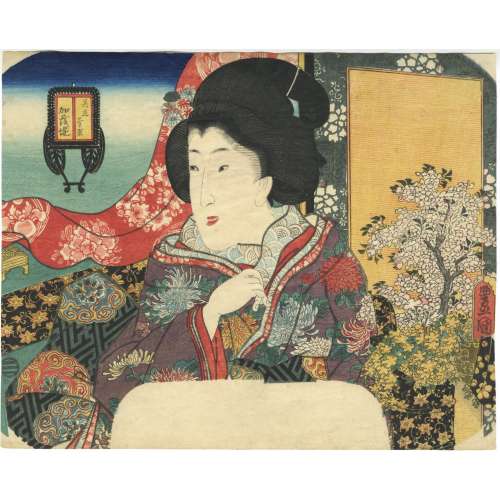 Title: On the Banks of the Kamo River [加茂堤] (Kamo Tsutsumi), sometimes transcribed as Kamo Zutsumi. Series: A Parody of Sugawara [美立菅原] (Mitate Sugawara). The word mitate is usually written as 見立 but here it is 美立, like on another Kunisada's fan print A beauty reading a book on a balcony overlooking a bay: A Parody of Sugawara Stripes (see SVJP-0334.2021 in this collection). On the Banks of the Kamo River is a scene from the play Sugawara's Secrets of Calligraphy [菅原伝授手習鑑] (Sugawara Denju Tenarai Kagami); it was originally written for the puppet theatre (Bunraku) and staged for the first time in the 8th lunar month of 1746 in Ôsaka at the Takemotoza. It was adapted for Kabuki the following month and staged for the first time in Kyôto at the Kitagawa no Shibai, produced by Nakamura Kiyosaburô I. It was also performed for the first time in Edo, at the Ichimuraza, in the 3rd lunar month of 1747. The shape of the cartouche resembles an ox cart viewed from the back which alludes to the scene Fighting for the Carriage (Kuruma biki). Artist: Utagawa Kunisada [歌川 国貞] a.k.a. Utagawa Toyokuni III [三代 歌川 豊国] (Japanese, 1786 – 1865). Signed: Toyokuni [豊国] in a red toshidama cartouche. The character ga [画] is missing (cut out). Publisher’s seal: Ibaya Senzaburō [伊場屋仙三郎] (Japanese, fl. 1815 – 1869). The date seal and censor seals were possibly trimmed out. According to [LIB-3008.2022] Andreas Marks (Tuttle, 2010; p. 267), the series was produced by Ibaya in 1851. Ref.: (1) Samuel L. Leiter. Historical dictionary of Japanese traditional theatre (Historical dictionaries of literature and the arts) / 2nd edition. – Lanham: Rowman & Littlefield, 2014©. (2) Andreas Marks. Japanese woodblock prints: Artists, publishers and masterworks, 1680 – 1900 / Foreword by Stephen Addiss. — Tuttle Publishing, 2010©. Acknowledgements: This masterpiece of ukiyo-e would not be properly described without input from Elena Varshavsky and Horst Graebner.
Title: On the Banks of the Kamo River [加茂堤] (Kamo Tsutsumi), sometimes transcribed as Kamo Zutsumi. Series: A Parody of Sugawara [美立菅原] (Mitate Sugawara). The word mitate is usually written as 見立 but here it is 美立, like on another Kunisada's fan print A beauty reading a book on a balcony overlooking a bay: A Parody of Sugawara Stripes (see SVJP-0334.2021 in this collection). On the Banks of the Kamo River is a scene from the play Sugawara's Secrets of Calligraphy [菅原伝授手習鑑] (Sugawara Denju Tenarai Kagami); it was originally written for the puppet theatre (Bunraku) and staged for the first time in the 8th lunar month of 1746 in Ôsaka at the Takemotoza. It was adapted for Kabuki the following month and staged for the first time in Kyôto at the Kitagawa no Shibai, produced by Nakamura Kiyosaburô I. It was also performed for the first time in Edo, at the Ichimuraza, in the 3rd lunar month of 1747. The shape of the cartouche resembles an ox cart viewed from the back which alludes to the scene Fighting for the Carriage (Kuruma biki). Artist: Utagawa Kunisada [歌川 国貞] a.k.a. Utagawa Toyokuni III [三代 歌川 豊国] (Japanese, 1786 – 1865). Signed: Toyokuni [豊国] in a red toshidama cartouche. The character ga [画] is missing (cut out). Publisher’s seal: Ibaya Senzaburō [伊場屋仙三郎] (Japanese, fl. 1815 – 1869). The date seal and censor seals were possibly trimmed out. According to [LIB-3008.2022] Andreas Marks (Tuttle, 2010; p. 267), the series was produced by Ibaya in 1851. Ref.: (1) Samuel L. Leiter. Historical dictionary of Japanese traditional theatre (Historical dictionaries of literature and the arts) / 2nd edition. – Lanham: Rowman & Littlefield, 2014©. (2) Andreas Marks. Japanese woodblock prints: Artists, publishers and masterworks, 1680 – 1900 / Foreword by Stephen Addiss. — Tuttle Publishing, 2010©. Acknowledgements: This masterpiece of ukiyo-e would not be properly described without input from Elena Varshavsky and Horst Graebner. -
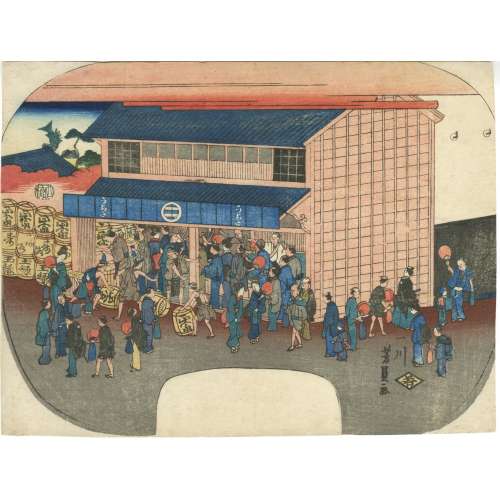 Artist: Utagawa Yoshikazu [歌川芳員] (Japanese, fl. c. 1850 – 1870). Publisher: Wakasaya Yoichi [若狭屋与市] (Japanese, fl. 1794 – 1897). Combined date seal and kiwame censor seal: 1861 (Man'en 2 / Bunkyū 1, from 19/02).
Artist: Utagawa Yoshikazu [歌川芳員] (Japanese, fl. c. 1850 – 1870). Publisher: Wakasaya Yoichi [若狭屋与市] (Japanese, fl. 1794 – 1897). Combined date seal and kiwame censor seal: 1861 (Man'en 2 / Bunkyū 1, from 19/02). -
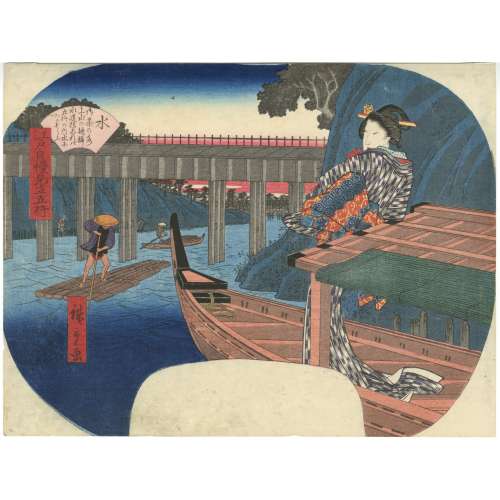 One of five fan prints from the series The Pride of Edo Compared to the Five Elements [Edo jiman mitate gogyo]. Artist: Utagawa Hiroshige [歌川 広重] a.k.a. Andō Hiroshige [安藤 広重] (Japanese, 1797 – 1858). Publisher: Ibaya Kyubei [伊場屋 久兵衛] (Japanese, fl. 1804 – 1851). Signed: Hiroshige ga Censor’s seal: Muramatsu Publisher's seal: Kinseido (Ibaya Kyubei) The text in the fan-shaped cartouche reads: "Water: The Square Aqueduct that Crosses by Suido Bridge Suggests the comparison of Ochanomizu to Water [Mizu: Ochanomizu josui no himasu Suidobashi areba gogyo no uchi mizu ni nazorau]". Ref: Rupert Faulkner. Hiroshige Fan Prints. Victoria and Albert Museum. Far Eastern Series. Hardcover - Harry N. Abrams, Inc. - 2001 [LIB-1344.2017] № 22, p. 51. Comment from Sebastian Izzard: This series of five prints features full-length figures of women set in landscapes around Edo compared to the five natural elements: fire, water, earth, wood, and metal. A preparatory drawing for the “Wood” image, featuring a woman crossing a bridge in the snow at the timber yards of Fukagawa, is owned by the Kanagawa Prefectural Museum of History in Yokohama. A preparatory drawing also exists for the “Earth” image, which portrays a woman seated on a bench at Nakabashi, for which no print is extant. Two examples exist of the “Fire” subject, which pictures a woman holding a lantern at night on an embankment, while in the river behind her fishermen employ fire to trap their catch. The “Water” image depicts a woman on a pleasure boat on the Ocha-no-mizu waterway. One example of the “Metal” subject is known, which was included in Izzard's Important Japanese Prints 1830–1860 March 14–20, 2020 exhibition [LIB-2398.2020], as №. 51.
One of five fan prints from the series The Pride of Edo Compared to the Five Elements [Edo jiman mitate gogyo]. Artist: Utagawa Hiroshige [歌川 広重] a.k.a. Andō Hiroshige [安藤 広重] (Japanese, 1797 – 1858). Publisher: Ibaya Kyubei [伊場屋 久兵衛] (Japanese, fl. 1804 – 1851). Signed: Hiroshige ga Censor’s seal: Muramatsu Publisher's seal: Kinseido (Ibaya Kyubei) The text in the fan-shaped cartouche reads: "Water: The Square Aqueduct that Crosses by Suido Bridge Suggests the comparison of Ochanomizu to Water [Mizu: Ochanomizu josui no himasu Suidobashi areba gogyo no uchi mizu ni nazorau]". Ref: Rupert Faulkner. Hiroshige Fan Prints. Victoria and Albert Museum. Far Eastern Series. Hardcover - Harry N. Abrams, Inc. - 2001 [LIB-1344.2017] № 22, p. 51. Comment from Sebastian Izzard: This series of five prints features full-length figures of women set in landscapes around Edo compared to the five natural elements: fire, water, earth, wood, and metal. A preparatory drawing for the “Wood” image, featuring a woman crossing a bridge in the snow at the timber yards of Fukagawa, is owned by the Kanagawa Prefectural Museum of History in Yokohama. A preparatory drawing also exists for the “Earth” image, which portrays a woman seated on a bench at Nakabashi, for which no print is extant. Two examples exist of the “Fire” subject, which pictures a woman holding a lantern at night on an embankment, while in the river behind her fishermen employ fire to trap their catch. The “Water” image depicts a woman on a pleasure boat on the Ocha-no-mizu waterway. One example of the “Metal” subject is known, which was included in Izzard's Important Japanese Prints 1830–1860 March 14–20, 2020 exhibition [LIB-2398.2020], as №. 51.
Metal. Izzard, 2020.

Fire. Faulkner, 2001.
-
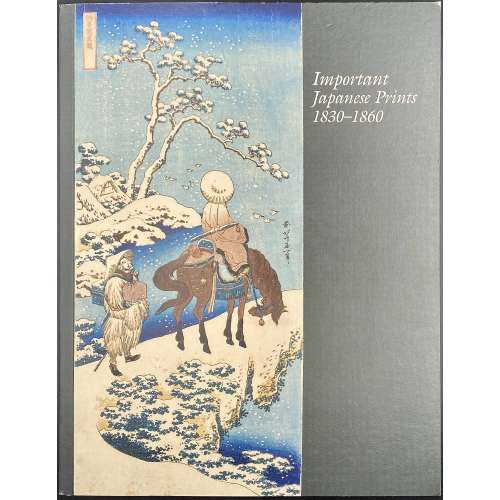 Softcover, in pictorial wrappers, 28 x 22 cm, 67 items, with colour illustrations, some folding. Catalogue of the sales exhibition on March 14-20, 2020 in NY; pagination: [1-3] 4-120 [8], ils. 6 fan prints. Contributor: Sebastian Izzard
Softcover, in pictorial wrappers, 28 x 22 cm, 67 items, with colour illustrations, some folding. Catalogue of the sales exhibition on March 14-20, 2020 in NY; pagination: [1-3] 4-120 [8], ils. 6 fan prints. Contributor: Sebastian Izzard -
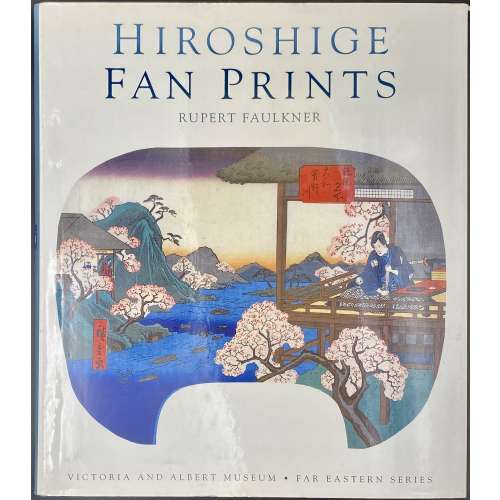 Hardbound, 25.3 x 22 cm, blue cloth, pictorial dust jacket lettered: HIROSHIGE | FAN PRINTS | RUPERT FAULKNER | {image} | VICTORIA AND ALBERT MUSEUM • FAR EASTERN SERIES ||; silver lettering to spine, green endpapers, description of 136 items with colour illustrations; pagination: [1-6] 7-160, ils. Utagawa Hiroshige [歌川 広重] a.k.a. Andō Hiroshige [安藤 広重] (Japanese, 1797 – 1858).
Hardbound, 25.3 x 22 cm, blue cloth, pictorial dust jacket lettered: HIROSHIGE | FAN PRINTS | RUPERT FAULKNER | {image} | VICTORIA AND ALBERT MUSEUM • FAR EASTERN SERIES ||; silver lettering to spine, green endpapers, description of 136 items with colour illustrations; pagination: [1-6] 7-160, ils. Utagawa Hiroshige [歌川 広重] a.k.a. Andō Hiroshige [安藤 広重] (Japanese, 1797 – 1858). -
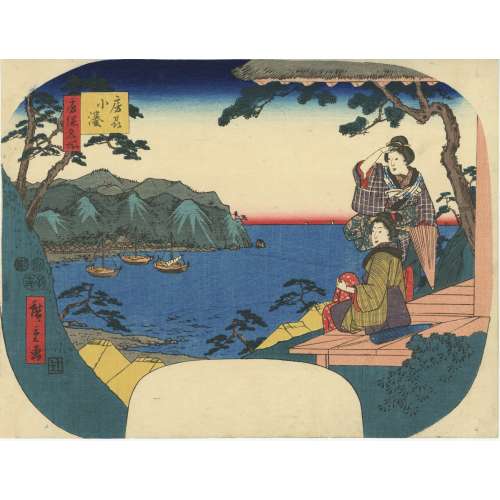 Kominato in Awa province [Awa Kominato] – one of five fan prints in the series Famous places in the Bōsō peninsula [Bōsō meisho], devoted to the trip undertaken by Hiroshige in 1852 to Bōsō peninsula (present-day Chiba prefecture). “Two fashionably dressed women beside the veranda of a wayside inn gaze out over Uchiura Bay toward the Tanjō Temple on the far shore, as a boat sets out to the sea from the fishing hamlet of Kominato. …Hiroshige’s viewpoint is from the lower slopes of Mount Kiyosumi”. Ref: Sebastian Izzard. Important Japanese Prints 1830–1860 March 14–20, 2020 exhibition [LIB-2398.2020], №. 52. Not in Faulkner's Hiroshige Fan Prints. Artist: Utagawa Hiroshige [歌川 広重] a.k.a. Andō Hiroshige [安藤 広重] (Japanese, 1797 – 1858). Publisher: Tsujiya Yasubei [辻屋安兵衛] Kinkaido [錦魁堂] (Japanese, c. 1842 – 1863) Date seal and double nanushi censor seal: Mera & Watanabe; Kaei 5, 11th month (1852). Signed: Hiroshige ga [広重 画] in a red cartouche. Size: Fan print (Aiban yoko-e uchiwa-e); 225 x 292 mm.
Kominato in Awa province [Awa Kominato] – one of five fan prints in the series Famous places in the Bōsō peninsula [Bōsō meisho], devoted to the trip undertaken by Hiroshige in 1852 to Bōsō peninsula (present-day Chiba prefecture). “Two fashionably dressed women beside the veranda of a wayside inn gaze out over Uchiura Bay toward the Tanjō Temple on the far shore, as a boat sets out to the sea from the fishing hamlet of Kominato. …Hiroshige’s viewpoint is from the lower slopes of Mount Kiyosumi”. Ref: Sebastian Izzard. Important Japanese Prints 1830–1860 March 14–20, 2020 exhibition [LIB-2398.2020], №. 52. Not in Faulkner's Hiroshige Fan Prints. Artist: Utagawa Hiroshige [歌川 広重] a.k.a. Andō Hiroshige [安藤 広重] (Japanese, 1797 – 1858). Publisher: Tsujiya Yasubei [辻屋安兵衛] Kinkaido [錦魁堂] (Japanese, c. 1842 – 1863) Date seal and double nanushi censor seal: Mera & Watanabe; Kaei 5, 11th month (1852). Signed: Hiroshige ga [広重 画] in a red cartouche. Size: Fan print (Aiban yoko-e uchiwa-e); 225 x 292 mm. -
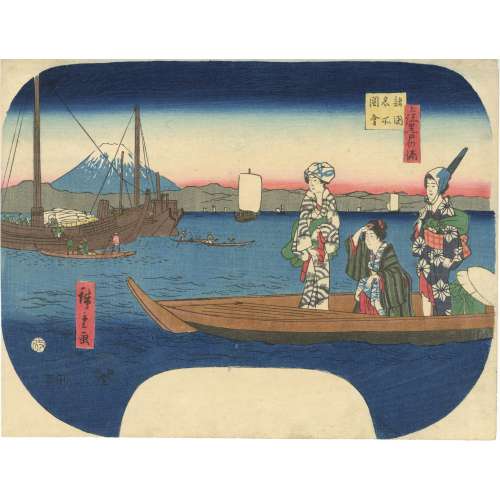 The Bay of Kuroto in Kazusa province [Kazusa Kuroto no ura] – an uncut fan print showing "Three women, wearing stylish cotton summer robes are shown in a skiff, admiring the view of Mount Fuji while looking back at the other passengers being helped into small boats". From the series: Views of famous places in the provinces [Shokoku meisho zue]. Ref: Sebastian Izzard. Important Japanese Prints 1830–1860 March 14–20, 2020 exhibition [LIB-2398.2020], №. 53. Not in Faulkner's Hiroshige Fan Prints, however, there are three other prints from the series, under № 95, 96 and 97 on p. 95. Artist: Utagawa Hiroshige [歌川 広重] a.k.a. Andō Hiroshige [安藤 広重] (Japanese, 1797 – 1858). Publisher: Iseya Sōemon [伊勢屋惣右衛門] (Japanese, c. 1776 – 1862). Date seal: 2/1855 Signed: Hiroshige ga. Censor's seal: aratame (certified) and date. Publisher's seal: Iseya Sōemon. Size: Aiban yoko-e uchiwa-e; 22.9 x 29.8 cm
The Bay of Kuroto in Kazusa province [Kazusa Kuroto no ura] – an uncut fan print showing "Three women, wearing stylish cotton summer robes are shown in a skiff, admiring the view of Mount Fuji while looking back at the other passengers being helped into small boats". From the series: Views of famous places in the provinces [Shokoku meisho zue]. Ref: Sebastian Izzard. Important Japanese Prints 1830–1860 March 14–20, 2020 exhibition [LIB-2398.2020], №. 53. Not in Faulkner's Hiroshige Fan Prints, however, there are three other prints from the series, under № 95, 96 and 97 on p. 95. Artist: Utagawa Hiroshige [歌川 広重] a.k.a. Andō Hiroshige [安藤 広重] (Japanese, 1797 – 1858). Publisher: Iseya Sōemon [伊勢屋惣右衛門] (Japanese, c. 1776 – 1862). Date seal: 2/1855 Signed: Hiroshige ga. Censor's seal: aratame (certified) and date. Publisher's seal: Iseya Sōemon. Size: Aiban yoko-e uchiwa-e; 22.9 x 29.8 cm -
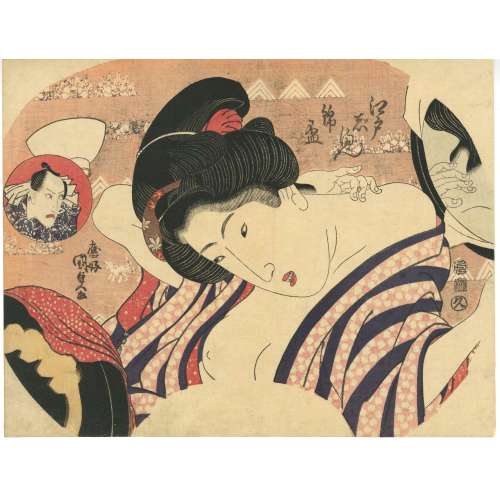 An uncut fan print showing a young woman checking her makeup in a mirror from the series The pride of Edo [江戸じまん] (Edo jiman). The head portrait in the red circle is of kabuki actor Danjūrō VII. Ichikawa Danjūrō VII [市川団十郎] (Japanese, 1791 – 1859); other names: Ichikawa Ebizō V, Ichikawa Hakuen II, Ichikawa Shinnosuke I. Artist: Utagawa Kunisada [歌川 国貞] a.k.a. Utagawa Toyokuni III [三代 歌川 豊国] (Japanese, 1786 – 1865). Publisher: Ibaya Kyūbei [伊場屋 久兵衛] (Japanese, fl. 1804 – 1851). Artists signature: Ōkō Kunisada ga [應好国貞画] (Drawn to satisfy the taste of Kunisada) Publisher’s seal:久 – Ibakyū [伊場久]. Censor's seal: Kiwame; date seal: Bunsei 10 (1827). Saze: Aiban uchiwa-e; 23.2 x 28.9 cm. Ref.: [LIB-2967.2022] Utagawa Kunisada (1786 – 1865): His world revisited / Catalogue № 17, Exhibition March 17-21, 2021. — NY: Sebastian Izzard, LLC., 2021; p. 102, Cat. 28–fig. a.
An uncut fan print showing a young woman checking her makeup in a mirror from the series The pride of Edo [江戸じまん] (Edo jiman). The head portrait in the red circle is of kabuki actor Danjūrō VII. Ichikawa Danjūrō VII [市川団十郎] (Japanese, 1791 – 1859); other names: Ichikawa Ebizō V, Ichikawa Hakuen II, Ichikawa Shinnosuke I. Artist: Utagawa Kunisada [歌川 国貞] a.k.a. Utagawa Toyokuni III [三代 歌川 豊国] (Japanese, 1786 – 1865). Publisher: Ibaya Kyūbei [伊場屋 久兵衛] (Japanese, fl. 1804 – 1851). Artists signature: Ōkō Kunisada ga [應好国貞画] (Drawn to satisfy the taste of Kunisada) Publisher’s seal:久 – Ibakyū [伊場久]. Censor's seal: Kiwame; date seal: Bunsei 10 (1827). Saze: Aiban uchiwa-e; 23.2 x 28.9 cm. Ref.: [LIB-2967.2022] Utagawa Kunisada (1786 – 1865): His world revisited / Catalogue № 17, Exhibition March 17-21, 2021. — NY: Sebastian Izzard, LLC., 2021; p. 102, Cat. 28–fig. a. -
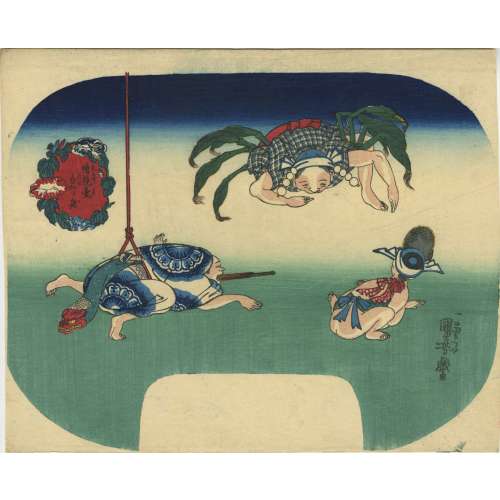 Artist: Utagawa Kuniyoshi [歌川 國芳] (Japanese, 1798 – 1861). Publisher: Ibaya Senzaburō [伊場屋仙三郎] (Japanese, c. 1815 – 1869), no publisher's seal on this print. Another title of this image provided by Sebastian Izzard is Acrobats becoming animals. The series Brother Pictures for Comparison [絵鏡台合かゝ身] (e-kyôdai awase kagami) can be found at Kuniyoshi Project: "This series consists of pairs of fan prints, with one print of each pair being a silhouette of the other. The series is not listed in Kuniyoshi by Basil William Robinson (Victoria and Albert Museum, London, 1961)". The series is attributed to c. 1840. Signed: Ichiyosai Kuniyoshi ga. Size: Size: Uchiwa-e (untrimmed fan print) 227 x 299 mm.
Artist: Utagawa Kuniyoshi [歌川 國芳] (Japanese, 1798 – 1861). Publisher: Ibaya Senzaburō [伊場屋仙三郎] (Japanese, c. 1815 – 1869), no publisher's seal on this print. Another title of this image provided by Sebastian Izzard is Acrobats becoming animals. The series Brother Pictures for Comparison [絵鏡台合かゝ身] (e-kyôdai awase kagami) can be found at Kuniyoshi Project: "This series consists of pairs of fan prints, with one print of each pair being a silhouette of the other. The series is not listed in Kuniyoshi by Basil William Robinson (Victoria and Albert Museum, London, 1961)". The series is attributed to c. 1840. Signed: Ichiyosai Kuniyoshi ga. Size: Size: Uchiwa-e (untrimmed fan print) 227 x 299 mm. -
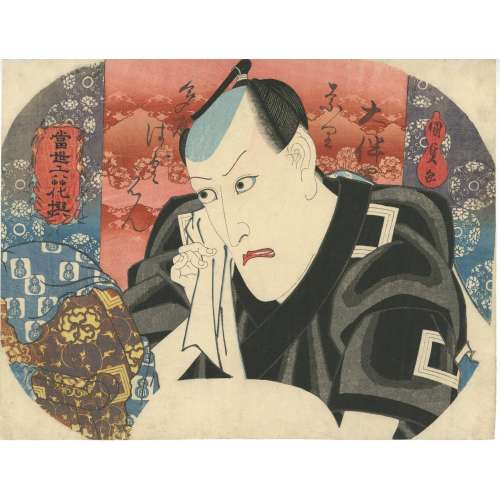 Artist: Utagawa Kunisada [歌川 国貞] a.k.a. Utagawa Toyokuni III [三代歌川豊国] (Japanese, 1786 – 1865). Artists signature: Kunisada ga [国貞画] in a red double-gourd cartouche. Character: Kabuki actor Ichikawa Danjūrō VII [七代目 市川 團十郎]; other names: Ichikawa Ebizō V, Ichikawa Shinnosuke I (Japanese, 1791 – 1859). Series: Six choice modern flowers [當世六花撰] (Tosei rok’kasen). No publisher's seal, no date or censor's seal is present. Size: Fan print (aiban uchiwa-e); 232 x 289 mm. Provenance: Paul F. Walter. Izzard: "... six prints make up this set of fan prints, which compares contemporary artists with classic poets, in this case, Ichikawa Danjūrō VII with Ōtomo no Kuronushi [大友 黒主] (Japanese, dates unknown)". Rok'kasen [六歌仙] – six poetry immortals. According to Izzard, identification of the portrayed person is made possible by mimasu-mon [三升] on the robe, scrolling peony on the back of the mirror, and cloth decorated with the characters Yauan, one of the actor's poetry names, and other signs and symbols, including the inscription of the acter's guild name Naritaya. The absence of the publisher’s emblem and censorship seals may indicate that this was a privately issued print, not for public use. Ref: (1) [LIB-2967.2022] Utagawa Kunisada (1786 – 1865): His world revisited / Catalogue № 17, Exhibition March 17-21, 2021. — NY: Sebastian Izzard, LLC., 2021; p. 130-1, fig. 42). (2) Lyon Collection. Mimasu-mon, or Mitsumasu, is the Ichikawa Danjūrō family crest – three wooden measures, nested square boxes.
Artist: Utagawa Kunisada [歌川 国貞] a.k.a. Utagawa Toyokuni III [三代歌川豊国] (Japanese, 1786 – 1865). Artists signature: Kunisada ga [国貞画] in a red double-gourd cartouche. Character: Kabuki actor Ichikawa Danjūrō VII [七代目 市川 團十郎]; other names: Ichikawa Ebizō V, Ichikawa Shinnosuke I (Japanese, 1791 – 1859). Series: Six choice modern flowers [當世六花撰] (Tosei rok’kasen). No publisher's seal, no date or censor's seal is present. Size: Fan print (aiban uchiwa-e); 232 x 289 mm. Provenance: Paul F. Walter. Izzard: "... six prints make up this set of fan prints, which compares contemporary artists with classic poets, in this case, Ichikawa Danjūrō VII with Ōtomo no Kuronushi [大友 黒主] (Japanese, dates unknown)". Rok'kasen [六歌仙] – six poetry immortals. According to Izzard, identification of the portrayed person is made possible by mimasu-mon [三升] on the robe, scrolling peony on the back of the mirror, and cloth decorated with the characters Yauan, one of the actor's poetry names, and other signs and symbols, including the inscription of the acter's guild name Naritaya. The absence of the publisher’s emblem and censorship seals may indicate that this was a privately issued print, not for public use. Ref: (1) [LIB-2967.2022] Utagawa Kunisada (1786 – 1865): His world revisited / Catalogue № 17, Exhibition March 17-21, 2021. — NY: Sebastian Izzard, LLC., 2021; p. 130-1, fig. 42). (2) Lyon Collection. Mimasu-mon, or Mitsumasu, is the Ichikawa Danjūrō family crest – three wooden measures, nested square boxes.
-
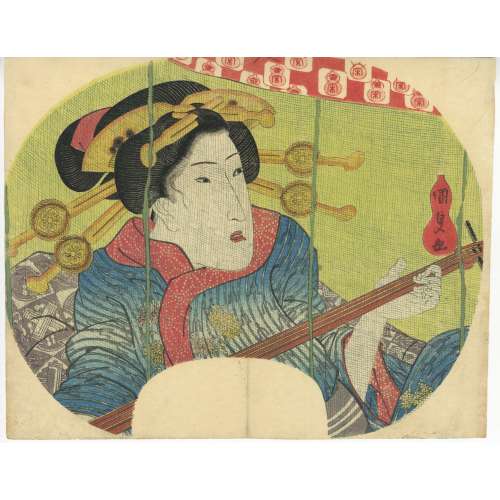 Artist: Utagawa Kunisada [歌川 国貞] a.k.a. Utagawa Toyokuni III [三代歌川豊国] (Japanese, 1786 – 1865). Signed: Kunisada ga [国貞画] in a red double-gourd cartouche Publisher: Unknown (no seal). Date: c. 1832 Izzard: "... red cloth decorated with the characters Yauan, one of Ichikawa Danjūrō VII [市川団十郎] (Japanese, 1791 – 1859) poetry names, and the name of his residence in Fukagawa. The absence of publisher's emblem and censorship seals may indicate that this was a privately issued print, not for public use". Ref.: [LIB-2967.2022] Utagawa Kunisada (1786 – 1865): His world revisited / Catalogue № 17, Exhibition March 17-21, 2021. — NY: Sebastian Izzard, LLC., 2021; p. 112-3, fig. 32). Size: Fan print (aiban uchiwa-e); 235 x 295 mm.
Artist: Utagawa Kunisada [歌川 国貞] a.k.a. Utagawa Toyokuni III [三代歌川豊国] (Japanese, 1786 – 1865). Signed: Kunisada ga [国貞画] in a red double-gourd cartouche Publisher: Unknown (no seal). Date: c. 1832 Izzard: "... red cloth decorated with the characters Yauan, one of Ichikawa Danjūrō VII [市川団十郎] (Japanese, 1791 – 1859) poetry names, and the name of his residence in Fukagawa. The absence of publisher's emblem and censorship seals may indicate that this was a privately issued print, not for public use". Ref.: [LIB-2967.2022] Utagawa Kunisada (1786 – 1865): His world revisited / Catalogue № 17, Exhibition March 17-21, 2021. — NY: Sebastian Izzard, LLC., 2021; p. 112-3, fig. 32). Size: Fan print (aiban uchiwa-e); 235 x 295 mm. -
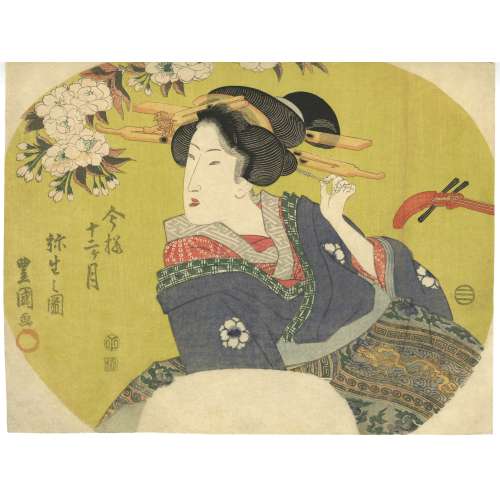 Title: Third lunar month [弥生] (Yayoi no zu); Series: Fashionable Twelve Months (Imayo juni-kagetsu). Another version of translation: Modern Beauties of Twelve Months. Artist: Utagawa Toyokuni I [歌川豊国] (1769–1825). Pubisher: Ibaya Senzaburō [伊場屋仙三郎] (Japanese, 1815 – 1869), seal: Dansendō [伊場仙]. Signed: Toyokuni ga and sealed with toshidama. Date-kiwame seal: Ushi (ox), Bunsei 5 (1822). Size: double-sheet uncut fan print ( aiban uchiwa-e), 219 x 295 mm.
Title: Third lunar month [弥生] (Yayoi no zu); Series: Fashionable Twelve Months (Imayo juni-kagetsu). Another version of translation: Modern Beauties of Twelve Months. Artist: Utagawa Toyokuni I [歌川豊国] (1769–1825). Pubisher: Ibaya Senzaburō [伊場屋仙三郎] (Japanese, 1815 – 1869), seal: Dansendō [伊場仙]. Signed: Toyokuni ga and sealed with toshidama. Date-kiwame seal: Ushi (ox), Bunsei 5 (1822). Size: double-sheet uncut fan print ( aiban uchiwa-e), 219 x 295 mm.

-
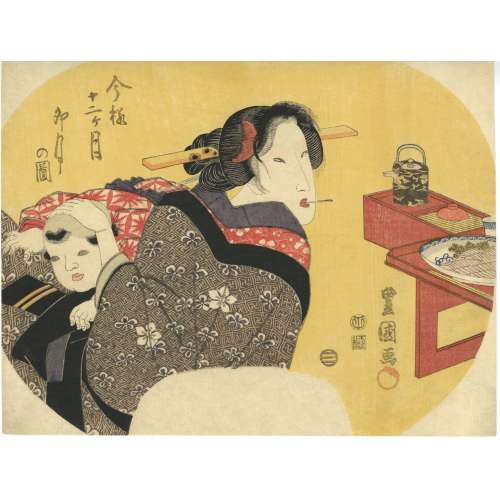 Title: Fourth lunar month [卯月] (Uzuki no zu); Series: Fashionable Twelve Months (Imayo juni-kagetsu). Another version of translation: Modern Beauties of Twelve Months. Artist: Utagawa Toyokuni I [歌川豊国] (1769–1825). Pubisher: Ibaya Senzaburō [伊場屋仙三郎] (Japanese, 1815 – 1869), seal: Dansendō [伊場仙]. Signed: Toyokuni ga and sealed with toshidama. Date-kiwame seal: Ushi (ox), Bunsei 5 (1822). Size: double-sheet uncut fan print ( aiban uchiwa-e), 219 x 295 mm.
Title: Fourth lunar month [卯月] (Uzuki no zu); Series: Fashionable Twelve Months (Imayo juni-kagetsu). Another version of translation: Modern Beauties of Twelve Months. Artist: Utagawa Toyokuni I [歌川豊国] (1769–1825). Pubisher: Ibaya Senzaburō [伊場屋仙三郎] (Japanese, 1815 – 1869), seal: Dansendō [伊場仙]. Signed: Toyokuni ga and sealed with toshidama. Date-kiwame seal: Ushi (ox), Bunsei 5 (1822). Size: double-sheet uncut fan print ( aiban uchiwa-e), 219 x 295 mm.

-
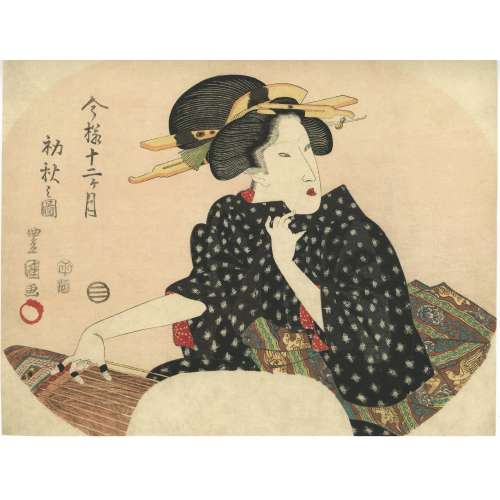 Title: Seventh lunar month [初秋] (Hatsuaki no zu); Series: Fashionable Twelve Months (Imayo juni-kagetsu). Another version of translation: Modern Beauties of Twelve Months. Artist: Utagawa Toyokuni I [歌川豊国] (1769–1825). Pubisher: Ibaya Senzaburō [伊場屋仙三郎] (Japanese, 1815 – 1869), seal: Dansendō [伊場仙]. Signed: Toyokuni ga and sealed with toshidama. Date-kiwame seal: Ushi (ox), Bunsei 5 (1822). Size: double-sheet uncut fan print ( aiban uchiwa-e), 219 x 295 mm.
Title: Seventh lunar month [初秋] (Hatsuaki no zu); Series: Fashionable Twelve Months (Imayo juni-kagetsu). Another version of translation: Modern Beauties of Twelve Months. Artist: Utagawa Toyokuni I [歌川豊国] (1769–1825). Pubisher: Ibaya Senzaburō [伊場屋仙三郎] (Japanese, 1815 – 1869), seal: Dansendō [伊場仙]. Signed: Toyokuni ga and sealed with toshidama. Date-kiwame seal: Ushi (ox), Bunsei 5 (1822). Size: double-sheet uncut fan print ( aiban uchiwa-e), 219 x 295 mm.



